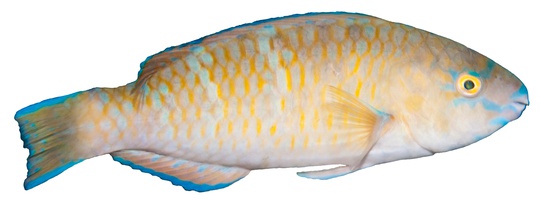Bluebarred parrotfish
Scarus ghobban

(Image credit: David Harasti)
The bluebarred parrotfish undergoes colouration changes as it grows, matures and changes sex. It transitions through two phases – initial (females) and terminal (transition between female and male).
In the initial phase the fish are a yellow to light orange colour with five vertical blue bars. Large individual scales are blue or mottled blue, creating the uneven edged bars. The underside is lighter than the dorsal surface. The tail fin has blue edges on the upper and lower surface.
During the terminal phase males change to a greenish blue colour all over with a lighter area on the underside. Scales through the central region of the body have pinkish edges. Fins are bluish green with pink striped sections. In larger males the tail fin tips are noticeably elongated.
Juveniles are very light brown to off white with faint horizontal lines along the body. When nearing the end of the juvenile stage the five vertical bars start to form.
All parrotfish have fused teeth forming a beak like mouth. This is how the common name of the group was derived.
Length: Up to 1 m
Habitat
Lagoons and edges of outcrops to 30 m depth. Juveniles in calm inshore areas
Log it
In New South Wales, log this species if spotted south of Bate Bay
Related links/info
Species names on the Redmap site are based on the Codes for Australian Aquatic Biota or CAAB (http://www.cmar.csiro.au/caab/). This is updated regularly and lists the approved common name, family, species name and more.
Find further information and images at FISHES OF AUSTRALIA http://www.fishesofaustralia.net.au/











